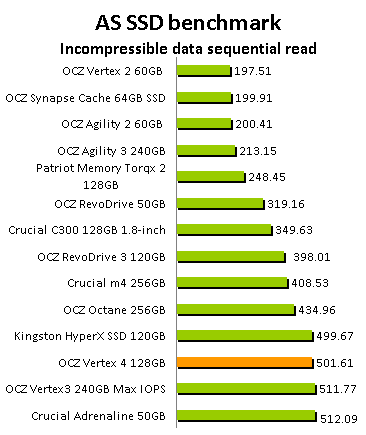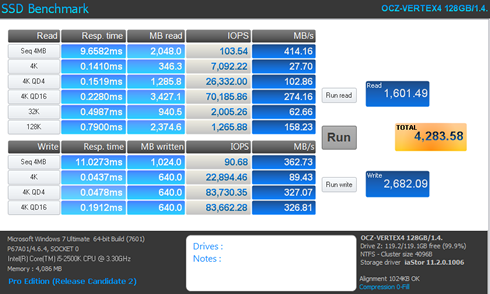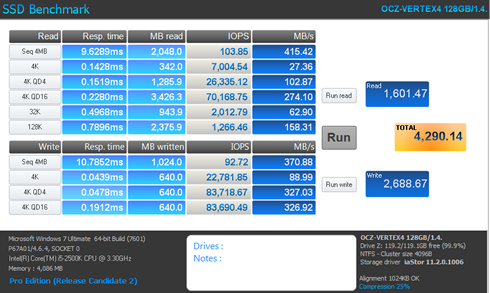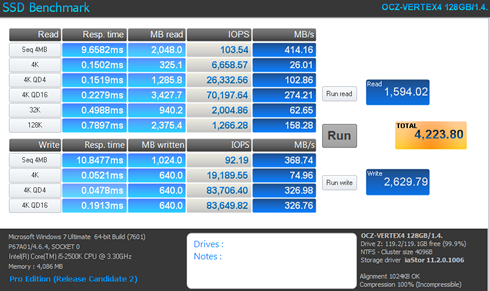1. Features
Last year OCZ Technology acquired SSD controller maker Indilinx. Some months later the company launched its first post-acquisition SSD based on Indilinx silicon, the Octane series. Currently OCZ is offering the Vertex 4, an SSD based on its Indilinx Everest 2 silicon.
With the Vertex 4, OCZ is releasing an SSD without a SandForce controller inside, unveiling that the future for the company is Indilinx.
We expect to se the Vertex 4 to perform better than the OCtane. Although they both use 25nm IMFT MLC NAND, their firmware is different, with minimal shared code between the two series. We also expect the Vertex 4 to offer high random write performance regardless of the nature of the data (compressible or incompressible), as the company promises.
The Vertex 4 is available in capacities of 128GB, 256GB and 512GB. MSRP is competitive with other 6Gbps drives on the market today. You'll have to spend $130 for the 128GB version, $220 for 256GB and $580 for 512GB.
OCZ is also offering an 64GB version of the drive that can be used as a cache drive along with your HDD. This one retails online for $80.
The Vertex 4 series is backed by a 5-year warranty.
We have in our labs the Vertex 4 SSD 128GB (#VTX4-25SAT3-128G), which promises to offer sequential reading / writing speeds of up to 550MB/s / 420MB/s, along with impressive random read/write performance, as you see in the following table.

Specifications |
| Performance |
64 GB |
128 GB |
256 GB |
512 GB |
| Sequential Reads1 |
460 MB/s |
550 MB/s |
550 MB/s |
550 MB/s |
| Sequential Writes1 |
220 MB/s |
420 MB/s |
465 MB/s |
475 MB/s |
| Random 4k Read IOPS2 |
70,000 IOPS |
90,000 IOPS |
90,000 IOPS |
95,000 IOPS |
| Random 4k Write IOPS2 |
50,000 IOPS |
85,000 IOPS |
85,000 IOPS |
85,000 IOPS |
| Maximum IOPS3 |
85,000 IOPS |
120,000 IOPS |
120,000 IOPS |
120,000 IOPS |
| |
|
1. Maximum sequential speeds are determined using ATTO,
2. Small file I/O performance is measured using IOMeter 2010
3. Maximum I/O performance is measured using IOMeter 2010, 512 bytes Random
Current performance specs reflect update to firmware v1.4
|
| Physical |
|
| Usable Capacities (IDEMA) |
64GB, 128GB, 256GB, 512GB |
| NAND Components |
2Xnm Synchronous Multi-Level Cell (MLC) |
| Interface |
SATA III / 6Gbps (backwards compatible with SATA II / 3Gbps) |
| Form Factor |
2.5 Inch |
| NAND Controller |
Indilinx Everest 2 |
| DRAM Cache |
Up to 1GB |
| Dimensions (L x W x H) |
99.8 x 69.63 x 9.3 mm |
| Reliability/Protection |
|
| MTBF |
2 million hours |
| Data Path Protection |
ECC corrects up to 128 random bits/1KB |
| Data Encryption |
256-bit AES-compliant, ATA Security Mode Features |
| Product Health Monitoring |
Self-Monitoring, Analysis and Reporting Technology (SMART) Support |
| |
| Environmental |
|
| Power Consumption |
Idle: 1.3 W Active: 2.5 W |
| Operating Temperature |
0°C ~ 70°C |
| Ambient Temperature |
0°C ~ 55°C |
| Storage Temperature |
-45°C ~ 85°C |
| Shock Resistance |
1500G |
| Compatibility |
|
| Serial ATA (SATA) |
Fully compliant with Serial ATA International Organization: Serial ATA Revision 3.0.
Fully compliant with ATA/ATAPI-8 Standard Native Command Queuing (NCQ) |
| Operating System |
Windows XP 32-bit /64-bit; Windows Vista 32-bit / 64-bit; Windows 7 32-bit / 64-bit; Linux; Mac OS X |
| Additional Features |
|
| Performance Optimization |
TRIM
(requires OS support), dynamic and static wear-leveling, background
garbage collection, Indilinx nDurance 2.0 Technology to extend SSD
lifespan |
| Other Performance Features |
Ndurance
2.0 Technology (Reduced Write Amplification without Compression,
Advanced Multi-Level ECC, Adaptive NAND Flash Management) |
| Service & Support |
5-Year Warranty, Toll-Free Tech Support, 24 Hour Forum Support |
| |
64 GB |
128 GB |
256 GB |
512 GB |
| Part Number |
VTX4-25SAT3-64G |
VTX4-25SAT3-128G |
VTX4-25SAT3-256G |
VTX4-25SAT3-512G |
2. The drive
Below you see the retail package of the OCZ Vertes 4 128GB SSD:

The inner packaging is typical for OCZ and their flagship product line. It includes a 3.5" SSD adapter for desktops, an OCZ sticker for your PC, mounting screws and an installation guide.

Externally, the Vertex 4 looks just like previous SSDs from OCZ. There's a sticker on the top of the black enclosure with a brushed metal backplate on the opposite side that includes capacity information, product number and serial number.
Inside, the SSD is using sixteen 8GB 25nm MLC flash NAND chips, placed in both sided of the PCB. The Indilinx Everest II SSD processor is positioned at the center of the PCB.


This drive follows the SATA compatibility connection, and although the Vertex 4 is backward-compatible with SATA 3Gb/s, a native 6Gb/s motherboard is required for maximum performance.

The drive came with firmware Ver. 1.4 installed:


Using OCZ Toolbox we flashed the drive's firmware to Ver. 1.4.1.2:


3. HDTachRW, HDTune Pro
Here is our testbed:
- Motherboard: Foxconn Quantum Force Rattler P67 vP04 BIOS
- Processor: Intel Core i5-2500K
- Case: Open Air testbed
- Power Supply Unit: Club 3D CSP-X1000CB 1000 Watt
- Graphics card: Club3D Radeon HD 6790 CoolStream Edition
- Memory: OCZ Gold PC3-10600 4x2GB 1333@CL9
- HDD: WD 500GB 7200RPM
- Monitor: LG L246WH-BH 24"
- Windows 7 x64 SP1 with latest updates installed
For the tests, we used the following software:
- HDTachRW v3.0.1.0
- HD Tune v4.50 Pro
- Crystal DiskMark v3
- ATTO Disk Benchmark v2.46
- ASS SSD Benchmark 1.5xxx
- IOMeter v2006.07.27 with Xtreme Benchmark template
- PCMark Professional edition v1.04
- Anvil Storage Utilities 1.0.34. Beta 11
We start the tests with the HDTachRW software. It shows the potential read speed which you are likely to experience with the SSD.
The software measures the sequential read speed, the random access speed and sequential write speed.
HDTachRW reported an average sequential writing speed of 228.5 MB/s and an average sequential reading of 222.2MB/s. The performance is much lower than we expected but this should be attributed to the was the specific software operates:

We move on to the HD Tune Pro software, another utility we used to measure the drive's reading and writing performances. Although not necessarily representative of real-world workloads, HD Tune's targeted tests give us a glimpse of each drive's raw capabilities.
The sequential reading test showed a 285.3 MB/s average speed - still way below OCZ's quoted performance figures:

In the corresponding sequential writing test the drive wrote the data at 202.1 MB/s (average). The writing speed kept lowering after the 64GBGB mark, as illustrated below:

We are concerned with the average speed with single threaded compressible reads and writes. Obviously, HD Tune isn't multi-threaded when it requests data so this sequential test does not take advantage of the Vertex 4's ability to read multiple steams quickly.
Here is another sequential file test. The SSD's average performance for write was 380.384 MB/s and 454.717 MB/s for read , closer to the performance numbers quoted by OCZ. For this test we used the "Zero" data pattern.

Selecting the "Random" data pattern had no serious impact to drive's sequential read and write performance. This time we got 394.704 MB/s average write and 450.880 MB/s read:

The results with a "mixed" data pattern were somewhere in the middle of the two previous testing modes; 434.426 MB/s for sequential reading and 385.305 MB/s for writing. Notice that the drive slowed down reading after the 340MB mark:

The HD Tune Pro also allows random read tests:

Here are some more results with the software to randomly seeks files of different sizes. The random read performance is was higher with file transfers of 1MB (421.536 MB/s average) , as well as with randomly selected file sizes:

4. ATTO Disk Benchmark
The next software we used was the ATTO Disk Benchmark. The tool measures storage systems performance with various transfer sizes and test lengths for reads and writes. The benchmark performs file transfers ranging from 0.5 KB to 8192 KB. ATTO can be adjusted to do overlapped I/O, in a variety of queue depths. We tested the SSD using the benchmark's default settings, using 256KB file length performance and QD4. ATTO probably gives the most accurate results for compressible read and write data.

For this test we're still using QD4. This means that our maximum read and write speeds could be a little different than OCZs, but still close. In the write test we reached over 380MB/s in several of the block sizes, mainly bigger than 32KB. The read test was very close to the claimed 550MB/s - our max was 548MB/s with 4MB and 8MB files.
The Vertex 4's sequential read speed is higher at high queue depths and larger transfer sizes.With files smaller that 16KB the drive is slow at reading as you seeing the graph below:

However, the drive is extremely fast when writing these small files:

Going further to larger file transfers confirms out previous findings. Still the Vertex 4 128GB drive is not the fastest you can find during reading but delivers a great performance in the writing tasks:


5. CrystalDiskMark
The next benchmark is the CrystalDiskMark. The software provides throughput data based on sequential reads and writes, and random (512K/4K/4KQD32) reads and writes of various sizes.
We start the tests with the randomly chooses data, mainly incompressible:

Below you see the same test with 0 fill (compressible) data:

It is obvious that the random read and write performance of the Vertex 4 128GB SSD is the same no matter if the data is compressible or incompressible. The drive is slower than the competition when reading reading compressible data sequentially. Again, the drive's high reading and writing performance with high queue depths was confirmed, even with small data (4K). The chart below illustrates the 0-fill results of various SSDs:


6. AS SSD benchmark
We proceed with the AS SSD benchmark, which contains five synthetic as well as three practical tests. The synthetic tests determine the sequential and the random read / write performance of an SSD. These tests are carried out without using the operating system's cache. The Seq-test measures how long it takes to read and write an 1GB file. Most importantly, this sequential benchmark uses incompressible data for all of its transfers.
The 4K benchmark tests the read and write performance for random 4K blocks. The 4K-64-THRD-test corresponds to the 4K procedure except that here the read and write operations are distributed on 64 threads.


The drive's performance in these tests was excellent. It seems that the drive has been optimized to deal with incompressible data - a different behavior compared to the way Sanforce controllers deal such data.
The Vertex 4 128GB produced a great 501.61 MB/s read speed and an even greater 370.25 MB/s write performance. The single-threaded 4K IOPS tests showed a high 26.76 MB/s for read and a faster write at 710.80 MB/s write, while the 64-thread 4K reads recorded a fantastic 334.45 MB/s for read and 298.95MB/s for write.



It’s pretty apparent so far that the Vertex 4 loves 4K testing, and swept the field in those test result. The Vertex 4 came out on top of all the write tests, and performed very well for its capacity in the 4K random reading tests:




In the following graph you see how the Vertex 4 drive reads and writes files, which have been partially of fully compressed. It is obvious that the drive's reading performance peaks with incompressible data and decreases as soon as the files are compressed by 55% or higher:

7. IOMeter
We proceed to IOMeter benchmark. Iometer is run by using workstation and database patterns for queue depths (outstanding I/Os) representing very light and moderate loads. Iometer is both a workload generator (that is, it performs I/O operations in order to stress the system) and a measurement tool (that is, it examines and records the performance of its I/O operations and their impact on the system). The app's ability to bombard drives with an escalating number of concurrent IO requests also does a nice job of simulating the sort of demanding multi-user environments that are common in enterprise applications. The software can be used for measurement of the performance of an SSD. We started using the IOMeter tests using the Xtreme Benchmark template .

For the specific test, we used 100% random, 67%-33% Read/write distribution, aligned with the benchmarks we had already done in the past with other SSDs.
The drive broke all records in the specific configuration in the IOMeter benchmark in both write and read IOPs:



8. Anvil Pro Benchmark
The next benchmark is the Anvil Pro, an ‘all inclusive’ storage utility. The software is tests transfer speeds as well as IOPS The IOPS tests can be configurable with preset testing scenarios for read (Seq 4MB, 4K, 4K QD4, 4K QD16, 32K and 128K), write (Seq 4MB, 4K, 4K QD4, 4K QD16) and mixed IO.
We used the software with the Vertex 4 128GB SSD and tested the drive with 0-fill compression (RAW), 8% compression, 25% compression, 45% compression, 67% compression and finally 100 % (incompressible data). Below are the results:






In the following charts we illustrate the results we got from four different drives with 0-fill compression files:




According to the benchmark, the Vertex 4 does not take a very large hit when dealing with incompressible data unlike the SandForce drives.
9. PCMark 7 Professional
Below you see the results of Futuremark's PCMark 7 Professional edition. The software includes 7 PC tests for Windows 7, combining more than 25 individual workloads.
The drive scored 5148 points. Below you see the performance of the Vertex 4 128GB SSD in various tasks defined by the software:

Below you can see the breakdown of individual benchmarks with the testing methodology. All the below tests are measure in MB/s speeds:

10. Summary
OCZ has done a great job with he Indilix 2 controller. The Vertex 4 128GB SSD offers a very good random/sequential write performance, besting even the latest SSDs from Intel and Samsung. But the most impressive characteristic of the new drive is its consistent performance regardless of data composition - a welcomed advantage compared to the SandForce-driven SSDs.
We would like to see a better sequential read performance from the drive, especially in low queue depths. On the other hand, it has competitive sequential read speeds under heavy load. So the trade-off is obvious. If you are using this drive for generally IO heavy workloads, then the Vertex 4 is a great choice. For more typical mainstream client workloads, the Vertex 4 is still good but it's far from industry-leading when it comes to low queue depth read speeds.
In the writing part, the Vertex 4 is industry-leading in write performance even in low queue depths or mainstream workloads.
With the Vertex 4, OCZ has delivered a great drive from a performance standpoint. If you have a workload that demands better write and/or random read performance, the $130 SSD drive should be your choice, backed by an impressive 5-years warranty.
